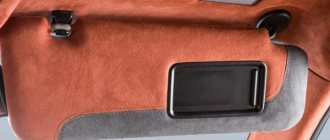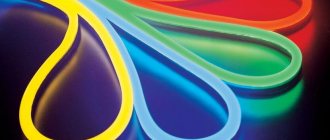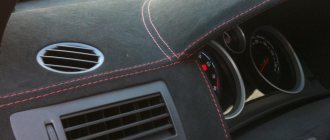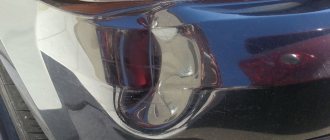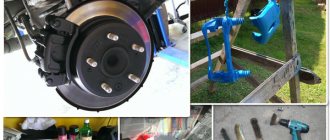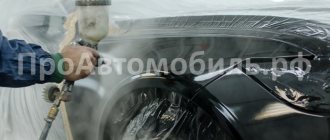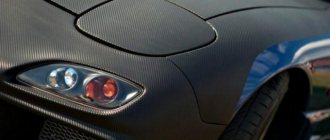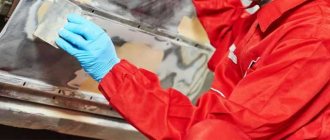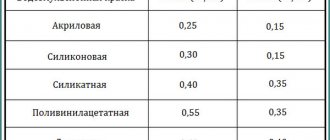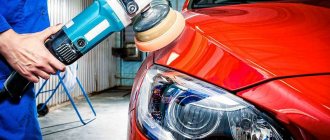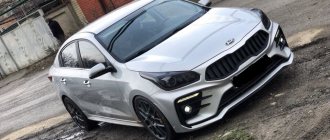Promotion! Free car paint selection!
You only pay for the paint itself! Do you need 50 grams to fill a scratch?
We will make a computer selection of paint for you, pour 50 grams of the color of your car - and it will cost you only 120 rubles!
Our prices are lower than others:
| Paint type: | Price: | |
| Up to 2 kilograms: | From 2 kilograms: | |
| Metallicas | 300 rub/100 grams | 2650 RUR/Kg |
| Mother of pearl | 350 rub/100 grams | 3200 RUR/Kg |
| Xeralics | 400 rub/100 grams | 3700 RUR/Kg |
Paint manufacturer: SPIES HECKER
The Spies Hecker company, founded in 1882 in Germany, is one of the largest manufacturers of high-quality paints and preparatory materials in the world.
To paint ONE part (bumper, wing, etc.) you need: 200-400 grams.
To paint the WHOLE car you need: 2.5 - 4 kilograms.
Existing dyeing methods
Gone are the days when car enthusiasts who wanted to do the painting themselves could only use nitro enamel, and, as a last resort, used oil and pentaphthalic paints. Now new chemical compositions have appeared, thanks to which it is possible to paint rims in several ways:
- using acrylic paints sold in aerosol cans;
- application of polymer coatings;
- the old method is painting with automotive nitro enamel;
- laying a layer of so-called liquid rubber;
- chrome plating
This is what a newly painted wheel on a car looks like.
Not all of the options listed are suitable for implementation at home. Take a polymer (powder) coating that is very resistant to environmental influences and mechanical damage. It is applied using a certain technology, consisting of the following stages:
- Surface preparation, including degreasing.
- Priming with a special composition.
- Application of powder enamel.
- Curing the paintwork in an oven.
On sale you can find polymer paints that harden without heat treatment. But their strength and durability are not so high and in terms of performance properties they are equal to acrylic coatings.
Since not every home has an oven for heat treatment of painted products, this method is not suitable for the average car owner. Unless you go to a specialized auto repair shop, where they will apply the polymer with high quality and charge a decent price.
For the same reasons, it is almost impossible to perform chrome plating at home. This is a complex technological process that includes the sequential application of various components with several intermediate rinses with distilled water. Moreover, the time for placing chemicals on the surface is strictly regulated. Therefore, to give the wheels the effect of a chrome surface, you will again have to turn to professionals.
Wheel rim with chrome finish
Note. Chrome plating can be imitated using special “chrome effect” aerosol paints applied to a layer of black primer. True, you will have to spend money on expensive enamel, since using a cheap one will give you a “metallic” color, and not a shiny surface. The coloring technology is similar to the use of acrylic compositions, which will be discussed below.
Methods for selecting paint
You can select a paint shade in three ways, the advisability of which depends on the type of coloring - complete or local. The spectrophotometer gives the most accurate result, so after painting the treated part cannot be distinguished by color from the rest of the car’s surface. No less good results are obtained by using computer equipment.
Choosing a shade based on the VIN code is the most budget-friendly option and is only suitable for completely painting the car.
In any case, you should trust the professionals and not rely on your own strength and compare the color of the gas tank cap with samples, since you will most likely choose the wrong shade.
Selection of paint by code
The manufacturer indicates the 17-digit code of the factory paint used on an information plate that can be found on the inside of the hood, trunk or door. On the manufacturer's official website you can find out the specific location of this plate. According to legal regulations, the VIN code is also indicated on the warranty certificate and registration documents. It would seem that it could be simpler than finding the paint code and covering the damaged area with the same enamel. However, selecting paint according to the code is only suitable for complete painting.
Even the highest quality paint used in a car factory loses its decorative properties over the years, becomes duller and fades.
The color of the enamel purchased using the specified code will be as fresh and intense as possible, so the processed part will immediately catch the eye against the background of the factory coating that has lost its pigmentation.
Selecting paint using a computer
Computer selection of the desired color is represented by a whole complex of actions, due to which it is possible to achieve a complete match of shades.
- Initially, you need to find the same VIN code and enter it into the program.
- According to the code found in the database, the program selects the necessary proportions and the exact ratio of different colors to obtain the desired shade. At this stage, the computer selection of paint for the car is not completed, since the obtained result is not suitable for local painting. The shade that is obtained by mixing different paints according to the recommendations of the program may differ, since products from different manufacturers with the same code can be different in tone. The second reason has already been mentioned - the factory coating fades over time, and the new paint will look too saturated against its background, even if the shade is identical.
- In view of the reasons stated above, at the next stage, professional colorists bring the resulting shade to perfection by mixing different colors and adding pigments. The final result will be identical to the factory coating in terms of saturation, brightness and hue, and the year of manufacture of the car does not matter with this method.
This is interesting: Car sharing - what is it and how does it work? 6 advantages of car sharing over regular car rental
Selecting paint using a spectrophotometer
The fastest and most accurate result is obtained by using a spectrophotometer, a special device that allows you to analyze the existing shade of the factory coating. Thanks to a spectrophotometer and a special stand for marking the characteristics of the enamel, the desired color is selected and then the car paint of the desired shade is tinted. Among the main features of this device are the high speed of selecting the shade of enamel, as well as the ability to select the color and tone if the VIN code is missing.
Types of paints by visual effect
Thanks to modern technologies, you can get an absolutely amazing visual effect from painting and make your car unique. Moreover, individualization of a vehicle is one of the ways to protect against theft.
Matte
The matte tone gives the car a special elegance and chic.
To obtain a matte surface, use a special alkyd enamel. Matting products provide durability and additional protection of the coating from adverse factors. As a rule, matte enamels are sold ready-made and do not require the addition of a solvent or drying activators.
Popular colors: black, gray, blue, white, deep green or purple, as well as shades: “khaki”, “white night”.
Metallic
The metallic effect is achieved by using special paints and varnishes that contain mica. This mineral has reflective properties. When the sun's rays reach the deep layers of the coating, a visual effect of depth occurs. The intensity of the effect depends on the brightness of the lighting.
Popular colors: “Snow Queen”, “Safari”, “Milky Way”.
Gloss
The glossy surface of the car is obtained if it is painted with an acrylic composition. Gloss gives the painted surface richness and depth of tone. But when painting, you should remember that glossy paint can only be applied to a very flat surface in order to avoid the appearance of a distorted visual effect of the coating.
Chromium
Nowadays, the chrome plating effect is used not only for stainless car parts, but also when painting its surfaces. To achieve the result, first apply a layer of special paint with aluminum particles, then a translucent and transparent varnish layer. The easiest way to get a mirror-like surface is to apply the paint material on a dark base that creates contrast.
Chameleon
The paint, called “chameleon”, actually has the ability to change its color under different lighting conditions. This effect became possible thanks to the addition of special microparticles to the composition. Each of the faces of these particles reflects light and from different angles of view or lighting these shades will be perceived in a new way.
Glowing
When luminous car paint appeared on the market, the functionality of modern paints and varnishes expanded significantly.
The effect of luminous enamels is based on the ability to react to light in a certain way. There are two types of such compositions - fluorescent and phosphor.
Fluorescent paints , when exposed to ultraviolet radiation, acquire extraordinary saturation and brightness, which is why their shade becomes acidic.
Phosphor paints absorb light during the daytime and emit light in the dark. Therefore, at night, phosphor coatings glow blue or greenish. The light-accumulating pigment is capable of giving off light for 36 hours. During the day, the luminescent coating is shiny but transparent.
Nacre
The mother-of-pearl effect is provided by inclusions of muscovite or potassium mica in the coloring composition. Microscopic particles (flakes) reflect light in one plane, forming a silvery tint. To increase the reflective properties, sparkles are treated with special compounds.
Popular colors: white pearl, dark cherry, titanium, graphite.
Choosing a car color based on your zodiac sign
The stars can help you choose the color of your car. Astrology has not been canceled! This, of course, does not mean that you need to blindly trust the advice of astrologers, but you can listen to their recommendations.
- Aries. Active and stubborn individuals. The choice is given to high-spirited engines. They often act childishly on the road, which increases the risk of creating an emergency situation. The color that suits your temperament is red, but taking into account your driving style, you can take a closer look at a yellow car. Blue shades are more suitable for women.
- Calf. Calm, balanced type. In cars they prefer reliability and comfort. Taurus can safely choose any color from light to dark shades, excluding irritating red, which is directly related to the zodiac sign.
- Twins. Great connoisseurs of “wind in your hair.” They are fickle in their mood, their duality also manifests itself on the road. As representatives of the air element, they often buy cars in “heavenly” colors, but do not neglect bright colors - orange or yellow.
- Cancer. Drivers who tend to worry about their iron horses. Supporters of comfort, practicality and reliability. For representatives of this sign, the car is a second home. Therefore, the color should be just as comfortable. Cancers often avoid flashy colors, preferring calm shades of green, blue, yellow and gray.
- A lion. A representative of the fire element, who likes to stand out from others. The car should match its owner, and its color should emphasize personality traits. Leos often exclude black from their choice, but do not neglect dark blue or burgundy. It is better for the sign to buy a car in bright colors - red or yellow.
- Virgos. They take a very responsible approach to choosing a car, which is subsequently kept clean. The choice of color is based on practical considerations - white, gray, blue or burgundy.
- Scales. Representatives of the zodiac cycle are balanced by nature. They value the aesthetics of a car, which is why they spend a lot of time searching for the perfect one. On the road, they strive to carefully evaluate everything, but in a critical situation they do not always have time to make the right decision. Shades of green are most often chosen.
- Scorpion. They tend to choose a car that can reach high speeds. However, they also know how to get out of an accident with minor scratches or completely intact. This sign chooses colors to match the racer’s temperament - all shades of red or yellow, but they can also take a closer look at black.
- Sagittarius. Lovers of travel and space. This zodiac sign, as a rule, is knowledgeable about all the new products on the automobile market. Sagittarians buy cars that look menacing in appearance. The chosen colors highlight such a car - yellow, purple or green.
- Capricorn. Chooses a practical, no-frills car that can overcome difficult obstacles. They don’t like to attract attention, and therefore the color of the car is chosen from a wide range of dark or gray.
- Aquarius. A lover of comfort, he loves a large number of buttons and displays. The color of the car should match the interior contents - bright shades are perfect.
- Fish. Unpredictable zodiac sign. Speed helps them relax, but due to their high emotionality, they often become involved in road accidents. Pisces should take a closer look at the shades of their element - blue or green.
Of course, each person is unique; the zodiac sign only indicates general character traits. The recommendations given above give you direction for reflection - choose the color of the car according to your zodiac sign or choose another criterion.
Airbrush and other types of decorative painting
Today, a common type of increasing the attractiveness of a car is airbrushing - applying deep 3D patterns to the surface of parts. You can make a small design on the wing or hood, or you can cover the entire car body, including even the bumper, with the composition.
It is important to choose a suitable composition that will complement your car and give it individuality. Of course, only people with a sufficient sense of artistic style can carry out airbrush work on a car. If you can’t paint, it’s better to entrust this kind of car painting to specialists with a guarantee of a good result.
All car repair services
- Body repair
- Body repair
- Front bumper repair
- Radiator grille repair
- Rear bumper repair
- Door repair
- Hood repair
- Front fender repair
- Rear wing repair
- Tailgate repair
- Trunk lid repair
- Roof repair
- Body repair
- Frame repair
- Front spar repair
- Rear spar repair
- Threshold repair
- Side mirror repair
- Locksmith repair
- Maintenance
Car paints “chameleon”, multi-layer painting, “metallic”
The types of paints for cars in terms of coating properties continue with compositions with features of color refraction: these are mother-of-pearl car paint, “chameleons” and other multi-component materials, which often have a brand purpose.
Recently, various “metallics” that have a characteristic shine have become especially widespread - this is a separate type of paint product:
- paint with a metallic sheen effect, single layer, possibly based on enamel with pigment and the addition of varnish. It is the varnish that gives the paint its characteristic shine, for which you have to pay for the extremely low durability of the coating, dependence on meteorological influences and the complexity of the application process. One layer of paint does not have the proper plasticity, sanding it requires the highest skill, and when applying it requires a steady hand and great patience - the resulting drip cannot be removed, so the paint should be applied very evenly. A single-layer composition will not last long, so the effort expended is not worth it if you are counting on a long-term and high-quality result;
- multi-layer types of car painting are quite complex operations, designed for professional skills. Metallic shine is achieved by applying the first layer of a certain color, which must dry completely. At least half an hour is allotted for drying, provided that the machine is in a dry room at room temperature with an effective hood. Under no circumstances should you speed up the drying process with a hairdryer, fan or draft. The air in the room should be cleared of dust by moistening the floor, but allow the water to evaporate and remove moisture through ventilation. It is necessary to apply a layer of paint very evenly, on a well-prepared surface, degreased and primed.
Please note that if there are dents or irregularities, the metallic sheen will become uneven. Varnish is the main protection of paint and bodywork; special attention should be paid to its selection; in addition, instructions must be strictly followed!
Most varnishes are supplied complete with thinners and hardeners, which you should not save and try to save “for later” - additives and reagents should be used strictly in the specified dosages and sequence.
Car painted with chameleon paint
When applying the varnish with the first layer, it is necessary to ensure good drying, and it is not advisable to check the surface with your finger. Possible drips and stains are removed by sanding. The technology requires complete removal of the damaged layer and application of new varnish so that the junctions of the layers do not become darker.
The second and third layers of varnish are applied with the same care; depending on the type of varnish, a spray booth can be used, but do not violate the established temperature conditions - this can lead to the appearance of “apples”, mesh and other troubles that can only be eliminated by complete repainting;
- types of painting a car in “chameleon” colors are technologically more complicated - you will have to create at least three layers of different paints, strictly observing the rules for overlapping colors, otherwise the effect will not be achieved. The surface of the body is primed, after which a toner primer is applied, essentially the first color layer itself. After the toner has dried, which will create the effect of the main color and cover the primer, a translucent composition is applied, giving the effect of mother-of-pearl. It is this composition that should not be applied with complete overlap of the main tone! The play of colors is created due to the effect of altered refraction of light by different compositions.
One or more layers of transparent varnish are applied to dry surfaces. Since paints do not provide a protective effect, varnish will not only give the car the proper shine, but will also protect the paint layer from damage.
Experts consider cloudiness to be an important sign that a layer is ready to apply the next dye or varnish. This indicates solvent evaporation. At this moment it is better not to rush - the wet paint will follow the new one. “Chameleons” and mother-of-pearl are almost impossible to restore after damage; a complete repainting of the part will be required.
Be sure to apply the entire paint or varnish layer to the entire surface at once, do not leave part of the body for a later time, because the junction of layers at different times will certainly appear in the form of lines or spots. Preparing the body for painting is the longest procedure. Removing all old paint, primer, grease and rust, and thoroughly blowing will give the effect of quality paint. Any violation of this rule will result in the entire body being repainted.
Choosing colors according to Feng Shui
Choosing the color of your “horse” according to your zodiac sign is not the only way to turn to astrology. The elements identified by experts will help determine what color to buy a car. Each of the five elements has its own shades. Determining your element is simple - by the last digit of the year of your birth.
- Metal element (0 or 1). Shades of gray, gold or white, similar to the color of the elements, are best suited.
- Water Element (2 or 3). It is better for representatives of the elements to buy a car in black and blue shades, which will add restraint and prudence.
- Car owners of the Wood element (4 or 5) will choose green cars, which will reassure the driver and give a feeling of perseverance, characteristic of representatives of these signs.
- Element of Fire (6 or 7). The choice is in red shades, which give confidence to car owners.
- Earth element (8 or 9). Take a closer look at a beige, brown or yellow car.
These colors work well for the body. The interior of the car must be chosen so that the colors are harmoniously combined with each other.
Preparation of equipment and materials
The technology for applying any paint to car rims involves spraying from a can or with a spray gun; brushes are not applicable here. To operate a spray gun, you need a compressor or an oxygen cylinder, and a small number of country house owners have such equipment.
A set of tools and materials for restoring rims
Hence the conclusion: it is best to buy coloring compounds and primer in aerosol cans, fortunately, there is a wide selection of enamels on sale in such containers. In addition, to complete the work you will need the following tools and materials:
- an electric drill or an angle grinder with a steel wire attachment (the so-called brush);
- coarse and fine sandpaper, 400 and 200 grits are suitable;
- rust converter or its analogue - phosphoric acid;
- degreasing agent - white spirit, nefras (otherwise - Galosha gasoline), organic solvent;
- masking tape, contour tape;
- paint is calculated as 1 450 ml bottle for 2 discs, more liquid rubber may be needed;
- primer (1 bottle for 4 discs);
- rags, rubber gloves, respirator or gauze bandage.
Set of chemicals for painting
Note. Acetone and inorganic solvents for nitro paints are not suitable for degreasing, since they are not capable of decomposing fats.
Important point. The primer must be selected so that it matches the base on which the paint is made. For example, acrylic-based compositions require acrylic primer, and so on. The application technology itself differs little from the type of enamel; the operations are performed the same.
Where is the VIN plate located?
The location of the metal plate on which the VIN code is written depends on the make of the vehicle. There are no requirements or standards for placement. The combination is on any car, it’s just hidden in hard-to-reach places. Manufacturers sometimes provide information about where exactly the VIN is located, but more often drivers have to look for it themselves. As a rule, you can find the nameplate under the hood, on the windshield, or under the driver and passenger seats. Less commonly, the number is located at the center pillar on the driver’s side or in the trunk. Often, to find a combination, you need to move the seat back and lift the trim.
Please note: Choose an electric spray gun for painting a car
In foreign cars
Not all foreign cars have the number located in the same places. For Hyundai Solaris, Ford Focus 2, it is indicated on the table, which is located under the hood (near the engine) or at the bottom of the driver's door. On a Nissan Almera you will have to look into the engine compartment on the passenger side. The necessary information will be indicated near the windshield. Searching for a VIN number on a Chevrolet Lacetti is no different - the nameplate is located near the radiator, engine or below the windshield on the passenger side. Things are more difficult with Mazda - a metal table with the necessary information is attached to the racks. Much less often, the paint number can be found on the front passenger door (bottom) or near the power unit under the hood. In similar places, the coverage code is found in Toyota and KIA Rio: doorway, pillars, power unit.
Nissan VIN Label Location
VIN code location in Chevrolet models
VIN plate in a Mazda car
For domestic cars
Russian vehicles differ slightly in the location of the VIN number from foreign ones. On Lada Granta or other VAZ cars, the nameplate is located on the trunk lid, under the hood or windshield. The numbers don’t always tell the car owner something - often the paint color is not indicated by the VIN code, but the shade with the words: “Crystal”, “Coriander”, “Plum”. Information about it is written in the catalog, but it is often impossible to select enamel. The paintwork on the Lada may be unique, which will cause difficulties during repairs.
Example of a VIN code in LADA
Location of the VIN code in LADA Vesta
Two-color car painting technology
Achieving controlled transitions with acrylic paint is quite problematic, and when applying local enamel on top of another material, the problem of changing the shape of the surface arises. The second material should have good covering power and not spread under the tape (it is recommended to use high-quality tapes, analogues of 3M Fine Line). Therefore, the area under which there should be no second paint at all is sealed with a film with a weak adhesive composition (Chinese products), and then it is removed along with part of the paint.
When painting small parts in 2 colors, the base is often powder paint, the main advantage of which is uniform application. It is impossible to paint a car in two colors with powder paint, due to the fact that during sintering the powder forms noticeable shimmers. Therefore, at the second level, ordinary enamel is used. This technology is used especially often on wheel rims, due to the fact that the relief of these parts does not allow the transition to be seen in detail.
A two-tone paint job doesn't have to be all hard lines, although frequent vertical lines on the side of the body, roof, and hood suggest full use of tape and film. Smooth transitions between two similar colors can also create an interesting effect, although the cost of an error here is noticeably higher, and not every artist is capable of painting using the transition method. Two-tone painting is also often found, in which the border of two enamels passes along the joints of body parts (hood cover, vehicle roof, fenders, doors).
Hard edges and muted colors
The most popular combinations form the following colors: electric blue, dark red, silver, green, orange. Combinations of black and white are rare, and brown and purple can more often be seen in smooth transitions. Painting in 2 tones using one color can look impressive. The cost of tinting materials rarely reaches the cost of airbrushing. In this option, hard boundaries will not look so attractive, but a smooth transition of 5-10 cm, on the contrary, will attract attention.
It is best if the contact strip is tied to one of the natural lines of the body. The absence of a clear border can be used to create a volume effect. In this case, the area to be painted is darkened at the edges or corners. To create a transition, paint is applied in several layers or a separate paint of a third, intermediate tone is prepared.
An interesting effect can be achieved if, instead of changing the color, you add a pigment, like mother-of-pearl. The pigment layer can emphasize the border of the transition or completely cover the area, rhyming the colors of the first level with the second. When using glitter in car painting, you should not overdo it with the amount of paint: this element in itself can give the car a bright note.
Car color and driver’s psychotype
Psychologists have found that the choice of car color is directly related to the psychological characteristics of the owner and his driving style and have given several recommendations.
- White color symbolizes a bright dream. It is believed that white is chosen by fair but emotional drivers. Their driving style is calm and balanced.
- Black is chosen by people who crave attention to themselves. One can say about the owner of such a car - confident and purposeful. Their driving style is harsh.
- Shades of red express passion as well as love of power. Owners of red cars are impulsive and hot-tempered; they can ignore the rules on the road.
- Blue is preferred by people who choose a friendly environment around them. They are humble and thoughtful. This is the color of restraint, attention to detail and calm. It is rare to find aggressive people among owners of blue cars. But they are always ready to provide assistance on the road.
- The yellow car and its owner definitely stand out from the crowd, which is what they strive for. Such people, as a rule, are sociable and calm, both in life and on the road.
- Green is the color of independent people. It is believed that owners of green cars claim the title of “Troublemaker,” because their actions on the road are difficult to predict. At the same time, these people constantly strive for something new and are distinguished by loyalty and even a degree of shyness. Owners of cars in light green shades, like owners of red ones, are distinguished by aggressiveness on the road.
- Pink shades give off a dreamy feel, but only when in moderation. An excess of pink signals that a person is not serious. However, owners of marshmallow-colored cars drive on the road with respect towards other road users.
- Silver is more often chosen by rational people who think through every step and do not want to attract a lot of attention to themselves. Gray or silver will not suit people with an active lifestyle who want to stand out.
It follows from this that it is better for hot-tempered people to choose a car whose color has a “cooling” effect - dark or silver. But, one way or another, the color scheme should be based on your feelings of comfort and safety.
Change of color and PTS
Airbrushing should occupy no more than 30% of the total area of the body, although traffic police officers do not have a reliable way to calculate this area.
The color of the car must correspond to at least 70% as specified in the PTS. If there is a significant change in color, you will need to make changes to the vehicle's passport by first writing an application to the traffic police, to which the vehicle registration is linked. When updating the appearance of wheeled vehicles, owners often overlook the fact that a large pattern makes it difficult to establish the primary color of the vehicle. According to the rules, a traffic police officer must be able to determine the color upon inspection from any side. The color setting is done by comparing the car's paint with a standard classifier. Due to the difficulties associated with changing the title, many owners prefer not to repaint, but to change the tone, i.e. colors in two or more tones. Formally, such a decision may not violate any regulations and seems to be the most logical solution if there is no desire to write an application to change the PTS.
Determine the paint color of your car - online paint selection service
Our online paint selection software application is easy to use and allows you to determine the paint color to match the color of your car. The application selects car paint that will match the “native” shade of your car. To perform a search, you just need to enter data about your car (vin code or body number, paint code, car model, year of manufacture) and the program will display results for all commercially produced car models.
The main advantage of online search for car paint color on Autocolor7 is that the results allow you to immediately select the car color by VIN and select the car paint of the desired color in any packaging: car paint in a can or the required shade in cans, starting from small packaging of 236 ml, or Choose an anti-scratch pencil to remove small chips.
Searching for paint for a car gives the most accurate results when carried out using the parameter paint number by vin code. This way you can be guaranteed to find and buy car paint in the “native” color of the car.
Why paint wheels?
The parts of the car that often suffer from various damages are the disks (you can less often hear the name “rims”). Increased wear, regular mechanical, and in winter, chemical influences that negatively affect the appearance of the structure - this is what is inevitable when operating a car. Painting becomes an option for protecting the metal base of the wheel. Painting will be needed in the following cases:
- The car has been in use for a long time, so numerous chips are visible;
- used discs were purchased;
- the part received a serious defect and was restored;
- chemical reagents for treating road surfaces have corroded the old surface;
- the old paint layer has been knocked off as a result of regular washing using high-pressure technology;
- the car will have a long trip off-road (for protection purposes);
- the driver wants to make his car stand out from others due to its eye-catching wheels.
Painting a wheel rim is a way to extend the life of the part. The paint layer will take on protective functions and minimize chips and scratches on the metal. Painting provides anti-corrosion protection. If the casting is painted, the brake calipers are also refinished - they are also painted.
other information
Using the VIN, you can find out whether the car has undergone major changes, or whether it is a prefabricated model, which is often how scammers make money. Control information helps to do this. Expensive brands even set a check number that will help identify the fact of counterfeiting.
In addition, the VIN code makes it easy to determine the type of body, engine, wheelbase, drive, and transmission. These data are verified when registering the car. Thus, VIN is a “fingerprint” of the car, allowing you to identify basic data and paint the body with an ideal result.
Types of paints for wheels
To answer the question of what paint to paint your wheels with, you need to understand the features of paint compositions and clarify the nuances of their use. Acrylic paints, rubber and powder paints are used for painting. It is also worth mentioning luminous compounds.
Acrylic paint
Acrylic-based coatings are suitable for processing any car wheels. Even if the part to be painted is made of aluminum, it is possible to obtain a durable coating using acrylic paint. Moreover, this can be done quickly, and a variety of colors will simplify the task. Acrylic paints and varnishes are supplied in cylinders, small cans, and there is an option to purchase the composition in a spray can. Aerosol acrylic paint for rims is easy to use and provides a durable finish. Advantages of the coloring composition:
- combination of colors (for an unusual design);
- protective functions of the layer applied in accordance with the technology;
- extending disk life;
- quick drying (up to 20 minutes);
- affordable price.
Rubber paint
The use of rubber coloring composition is explained by its versatility. Paintwork is applied to casting, stamping, forged and titanium wheels. The rubber compound can be used to treat hubcaps to improve the appearance of car wheels. The paint comes in matte and glossy shades. LKM has the advantages:
- dries quickly;
- creates a durable layer (similar to rubber);
- Easily removed without additional tools and damage to the base.
The disadvantages are associated with increased consumption, which affects the final cost. The paint layer is more susceptible to mechanical damage compared to the acrylic layer.
Rubber paint
Powder paint
The application of powder paint involves a technology that is not always possible to use in domestic conditions. The powder sprayed onto the part requires further polymerization, carried out in an oven. The complexity of the technology is compensated by the protective properties, and powder paint has them at a high level. Among the advantages:
- anti-corrosion effect;
- resistance to salts, acids and alkalis;
- resistance to high temperatures;
- strength (no risk of mechanical damage);
- adhesive properties (the paint adheres well to metals and alloys, except aluminum).
The downside is the complexity of the technology and the need to purchase equipment (spray gun, polymerization oven). Such equipment is more often found among car wheel manufacturers themselves.
Powder coating of wheels
Glowing paint
Phosphor is a filler that allows the paint layer to “give off” the light accumulated during the day. Phosphor paints, after application and drying, create a glowing effect. Depending on the size of the particles, the duration of the glow changes (the smaller they are, the longer the effect lasts). Since the phosphor initially produces a yellowish or bluish glow, paint and varnish manufacturers add various pigments to the compositions. The paint can be purchased ready-made, or you can make it yourself. The proportion for the mixture of varnish with phosphor is 5 to 1. The substance that gives the glow effect acts as a pigment. Additives that change color enhance the effect of the main substance. Methods for applying paints and varnishes are standard.
Glowing paint
Features of choosing paint for a car body
Car paint belongs to the enamel category and consists of binders, varnish and pigments. Its distinctive feature is uneven drying. The outer layer dries first, which creates the misleading impression that the layer has completely dried over its entire thickness. In fact, the lower layers dry much later.
Thanks to modern technologies, car paint can contain other components that enhance the visual effect of chameleon, pearl or metallic, but choosing a shade in such situations is even more difficult than usual.
Often, car paint of a suitable shade requires mixing up to 15 different paints in precise proportions; the weight must be calculated down to 0.1 grams using the most accurate electronic scales. Next, special test plates are used to compare the resulting shade with the color of the car under special lighting conditions. The quality of the final result directly depends on how strictly the following nuances were observed:
- The professionalism of the colorist and the artist who will carry out the coloring affects the result in the same way as the quality of the materials and equipment used. In the case of paints in a can, you should prepare for a decrease in the quality of the paintwork renewal, especially when it comes to mixed colors.
- There should be 3 - 4 trial versions before final painting. When applying each subsequent layer, the intensity cannot be changed.
- Do not forget that the shade is distorted to some extent after drying, so test versions must be compared with the surface of the car and calibrated only after they have completely dried.
- The method of applying enamel also affects the final result.
- The selection of paint for a car can be simplified as much as possible by using materials from one manufacturer, since each manufacturer develops its own system of designating shades and color schemes.
- When using a spectrophotometer when choosing a shade of auto enamel, painting should begin with a small and old part, so you can evaluate the accuracy of the selection. Only after this stage proceed to complete painting of the car.
This is interesting: Chevrolet Cruze sedan design review: photos and analysis
Necessary materials and equipment
In order for the job to be done efficiently, you should not skimp on paint. It is also important to check the expiration date of enamel and other materials. The technician will need automotive primer and varnish, acetone or another solvent, and car putty (if there are defects).
Tools and consumables you need:
- fine grain sandpaper;
- gloves;
- respirator;
- Sander;
- construction hairdryer
When purchasing paint, it is better to immediately purchase primer and putty of the same brand to improve compatibility and, accordingly, the final result. An electric drill with a special attachment (for removing old coating and traces of corrosion) is suitable as a replacement for a grinding machine. A construction hair dryer, if necessary, is replaced with a heat gun. These tools are needed to dry the paint as quickly as possible, but many types of enamels dry well at room temperature. If you purchased paint in a can, no tools are required. When using other forms, you need to buy a roller, brush and spray gun.
Decoding the VIN code
A VIN code is not just a set of letters or numbers invented by someone. The meaning of each symbol is different:
- international manufacturer index WMI (first 3 digits), indicating the country and company of the car manufacturer;
- the next 5 letters and numbers are the model, body type, engine and other basic data about the vehicle;
- the next symbol means nothing - it is a control symbol;
- the tenth character indicates the year of manufacture of the car;
- under the eleventh building there is an assembly plant hidden - the place where the car was produced;
- the last characters (6 of them) are the vehicle serial number and paint code.
Please note: How to paint a hot water tank
It is not just the color of the paint used that is indicated (this is often written down in the vehicle passport), but its code. In addition, a “Y” (plain) or “Z” (metallic) mark is made.
Preparing for work
Before work, remove tires, plastic caps and plugs that will interfere with quality painting. Further preparation includes the following steps:
- thoroughly rinse the products from dirt using ordinary household chemicals or special automotive products, as well as a brush with plastic bristles;
- sand the disc to remove minimal chips and scratches (first you can use coarser sandpaper, then fine sandpaper);
- if there are deep chips, use putty;
- degrease the discs with acetone or another solvent;
- wrap the wheel nipples with masking tape if the rims have not been removed;
- You can start priming.
Dyeing process
The primer is applied to car wheels in 2-3 layers with an interval of 15 minutes. This time is required for the soil to dry (you cannot apply a second layer to a wet disc!). Next, you can make the first layer with a spray gun, holding the nozzle at a distance of 40 cm from the product (it is also acceptable to apply paint with a roller and brush). It is important to apply only thin layers so that the paintwork does not leak. After each layer has dried (from 15 minutes), the next one is applied, up to 2-4 layers in total. To complete the work, the discs need to be varnished. This is done 30 minutes after the paint has completely dried. Usually 2 layers of varnish are enough for the outside and 1-2 for the inside.
How to paint alloy wheels
How to paint alloy wheels with your own hands.
The most inexpensive way to restore alloy wheels is to paint them yourself. The procedure allows you to extend the service life of the product and increase its aesthetic appeal. In order for painting to not only improve the appearance, but also protect against rust and damage, it is necessary to choose the right paint and application tools. Preparation. First, alloy wheels are cleaned of corrosion using a metal brush and sandpaper of different grain sizes. Sometimes a power tool with attachments is required. Sandblasting allows you to thoroughly clean the surface.
Priming and painting. The metal is coated with primer to level out dents and minor defects. The primer is applied 2-3 times, avoiding drips. The discs are dried in a special cabinet or using a hair dryer. After cooling, the products are sanded crosswise with sandpaper to prevent damage. It is advisable to leave a minimal layer.
The dyeing procedure is carried out in a well-ventilated area. You can use different types of paints. When powder painting, you will need a spray gun and compressor equipment. The disk can be hung on a wire to provide good access, or you can use a special stand. Powder technology requires a drying chamber with a temperature of +250 to +300 degrees Celsius. Polymerization occurs in the chamber for 4-6 hours.
How to paint stamped wheels
How to paint stamped wheels with your own hands.
Such discs are less resistant to damage, so it is recommended to first roll them to restore their original shape. Then the irregularities are smoothed out. The painting technology is identical to work with alloy wheels, including preparation with surface cleaning and degreasing, priming and painting.
Defects are removed using putty. First, durable compounds with fiberglass are used, then finishing ones, which are plastered to the required smoothness.
During processing, rust should be carefully removed, since under-film corrosion develops under the paint layer. A particularly dangerous place is the connection between the disc and the rim.
For steel wheels, you should not use chemical compounds that can become a source of rust development. Mechanical corrosion removal and priming are required.
Sources
- https://autoclub.su/instrukciya-po-pokraske-shtampovannyx-avtomobilnyx-diskov-svoimi-rukami/
- https://VseoKraske.ru/pokraska-avto/vidy-avtokrasok
- https://AvtoPokras.com/pokraska-avtomobilya-svoimi-rukami
- https://topreit.ru/teoriya-pokraski/lakokrasochnoe-pokrytie-vazhnejshij-element-zashhity-kuzova/
- https://PokraskaMashin.ru/tehnologiya-okraski/okrashivanie-avto-v-dva-cveta/
- https://MyKrasim.ru/kraska/pokraska-auto/pokraska-avtomobilnyh-diskov
- https://kraska.guru/kraski/vidy/dlya-diskov-avto.html
- https://wikers.ru/articles/pokrasit-diski-svoimi-rukami.html
